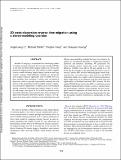| dc.contributor.author | Li, Jingshuang | |
| dc.contributor.author | Fehler, Michael | |
| dc.contributor.author | Yang, Dinghui | |
| dc.contributor.author | Huang, Xueyuan | |
| dc.date.accessioned | 2015-04-01T16:29:56Z | |
| dc.date.available | 2015-04-01T16:29:56Z | |
| dc.date.issued | 2014-12 | |
| dc.date.submitted | 2014-08 | |
| dc.identifier.issn | 0016-8033 | |
| dc.identifier.issn | 1942-2156 | |
| dc.identifier.uri | http://hdl.handle.net/1721.1/96309 | |
| dc.description.abstract | Reliable 3D imaging is a required tool for developing models of complex geologic structures. Reverse time migration (RTM), as the most powerful depth imaging method, has become the preferred imaging tool because of its ability to handle complex velocity models including steeply dipping interfaces and large velocity contrasts. Finite-difference methods are among the most popular numerical approaches used for RTM. However, these methods often encounter a serious issue of numerical dispersion, which is typically suppressed by reducing the grid interval of the propagation model, resulting in large computation and memory requirements. In addition, even with small grid spacing, numerical anisotropy may degrade images or, worse, provide images that appear to be focused but position events incorrectly. Recently, stereo-operators have been developed to approximate the partial differential operator in space. These operators have been used to develop several weak-dispersion and efficient stereo-modeling methods that have been found to be superior to conventional algorithms in suppressing numerical dispersion and numerical anisotropy. We generalized one stereo-modeling method, fourth-order nearly analytic central difference (NACD), from 2D to 3D and applied it to 3D RTM. The RTM results for the 3D SEG/EAGE phase A classic data set 1 and the SEG Advanced Modeling project model demonstrated that, even when using a large grid size, the NACD method can handle very complex velocity models and produced better images than can be obtained using the fourth-order and eighth-order Lax-Wendroff correction (LWC) schemes. We also applied 3D NACD and fourth-order LWC to a field data set and illustrated significant improvements in terms of structure imaging, horizon/layer continuity and positioning. We also investigated numerical dispersion and found that not only does the NACD method have superior dispersion characteristics but also that the angular variation of dispersion is significantly less than for LWC.
Read More: http://library.seg.org/doi/abs/10.1190/geo2013-0472.1 | en_US |
| dc.description.sponsorship | National Natural Science Foundation (China) (Grant 41230210) | en_US |
| dc.description.sponsorship | Massachusetts Institute of Technology. Earth Resources Laboratory (Founding Members Consortium) | en_US |
| dc.language.iso | en_US | |
| dc.publisher | Society of Exploration Geophysicists | en_US |
| dc.relation.isversionof | http://dx.doi.org/10.1190/GEO2013-0472.1 | en_US |
| dc.rights | Article is made available in accordance with the publisher's policy and may be subject to US copyright law. Please refer to the publisher's site for terms of use. | en_US |
| dc.source | Society of Exploration Geophysicists | en_US |
| dc.title | 3D weak-dispersion reverse time migration using a stereo-modeling operator | en_US |
| dc.type | Article | en_US |
| dc.identifier.citation | Li, Jingshuang, Michael Fehler, Dinghui Yang, and Xueyuan Huang. “3D Weak-Dispersion Reverse Time Migration Using a Stereo-Modeling Operator.” GEOPHYSICS 80, no. 1 (December 5, 2014): S19–S30. © 2014 Society of Exploration Geophysicists | en_US |
| dc.contributor.department | Massachusetts Institute of Technology. Department of Earth, Atmospheric, and Planetary Sciences | en_US |
| dc.contributor.mitauthor | Fehler, Michael | en_US |
| dc.relation.journal | Geophysics | en_US |
| dc.eprint.version | Final published version | en_US |
| dc.type.uri | http://purl.org/eprint/type/JournalArticle | en_US |
| eprint.status | http://purl.org/eprint/status/PeerReviewed | en_US |
| dspace.orderedauthors | Li, Jingshuang; Fehler, Michael; Yang, Dinghui; Huang, Xueyuan | en_US |
| dc.identifier.orcid | https://orcid.org/0000-0002-8814-5495 | |
| mit.license | PUBLISHER_POLICY | en_US |
| mit.metadata.status | Complete | |
